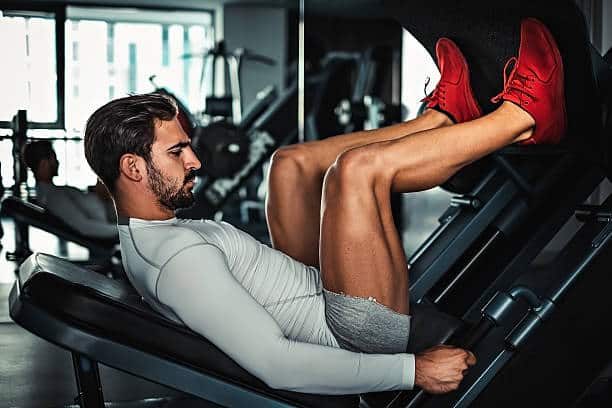
Vastus Lateralis Muscle Workout: Top Tips & Tricks
The vastus lateralis muscle workout is essential for building strong, powerful legs, as this muscle comprises nearly 50% of your quadriceps mass. Understanding its importance can significantly enhance your leg training routine and overall leg strength.
In this article, we’ll guide you through effective strategies to focus on strengthening the vastus lateralis. By incorporating targeted muscle-building tips, you’ll achieve a more balanced leg workout, leading to improved leg strength and better performance in daily activities.
We’ll explore practical and efficient quadriceps exercises suited for all fitness levels. Whether you’re just starting out or are an experienced athlete, you’ll find valuable insights to optimize your leg workouts.
Ready to transform your legs? Let’s get started!
Understanding the Vastus Lateralis Muscle

The vastus lateralis muscle is one of the largest components of the quadriceps group, situated on the outer side of the thigh. This muscle plays a crucial role in leg movements and overall stability.
Location and Function
The vastus lateralis muscle starts at the upper part of the femur and extends down to the patella, playing a crucial role in the anatomy of the quadriceps. Its main function is to extend the knee joint, which enhances the efficiency of activities such as running, jumping, and squatting. Knowing its precise location is key to effectively targeting this muscle during your workouts.
Importance in Leg Strength
The vastus lateralis is crucial for leg muscle function, supplying the power needed for lower body strength activities. It supports the knee joint and plays a key role in maintaining balance. Whether you’re an athlete or just aiming to boost your overall fitness, understanding the role of the vastus lateralis in leg strength and stability is essential for crafting an effective exercise routine.
Effective Warm-Up Techniques
Before you start your vastus lateralis muscle workout, it’s important to prepare your body properly. Engaging in a thorough warm-up can boost your performance and reduce the risk of injury. Here are some effective techniques to help you get ready and maximize the benefits of your workout.
Dynamic Stretching
Dynamic stretching is an excellent way to prepare for your vastus lateralis muscle workout. It involves controlled movements that enhance your range of motion and activate your muscles. Unlike static stretching, dynamic stretching mimics the movements you’ll perform during your workout, boosting flexibility and readiness for intense exercise. Incorporate leg swings, walking lunges, and high knees into your pre-workout routine to effectively warm up and prime your muscles.
Foam Rolling
Foam rolling is a fantastic addition to your warm-up routine. Using a foam roller on your legs can help relieve muscle tightness and improve blood flow, enhancing muscle elasticity. Make sure to target the quadriceps, hamstrings, and calves to prepare your legs for the workout effectively. Spend a few minutes on each muscle group to fully reap the benefits.
By incorporating both dynamic stretching and foam rolling, you’ll create a solid foundation for your vastus lateralis muscle workout. These techniques not only increase muscle flexibility and activate key areas but also boost circulation, setting you up for a successful and effective exercise session.
Best Vastus Lateralis Exercises

To effectively target the vastus lateralis muscle, it’s important to include specific exercises in your routine. This section highlights the top exercises designed to isolate and strengthen this muscle group, ensuring you get the most out of your workouts.
Squats for Vastus Lateralis
Strengthening squats are essential for any leg workout and are particularly effective for targeting the vastus lateralis muscle. Start by standing with your feet shoulder-width apart and toes slightly pointed outward. Lower your body by bending your knees while keeping your back straight and ensuring your knees don’t extend past your toes. To increase the challenge, hold a barbell across your shoulders.
Leg Press Benefits
When performing a leg press exercise targeted at the vastus lateralis, the leg press machine can be a big help. Elevate and slightly expand the position of your feet on the platform. This placement efficiently targets the muscles of the outer thighs. Throughout the exercise, keep your weight under control and always press through your heels.
Lunges for Targeted Strength
Lunges are an effective way to encourage the formation of lunges for muscles, particularly in the vastus lateralis. Step one is to stand with your feet hip-width apart. Put one foot in front of you and sag your hips until your knees are 90 degrees bent. The rear knee ought to be slightly elevated above the floor. To get back to the starting position, push off the front foot. For better outcomes, adding weights might improve resistance.
| Exercise | Key Focus | Modification |
|---|---|---|
| Squats | Strengthening Squats | Use a barbell for added resistance |
| Leg Press | Leg Press Workout | Adjust foot placement to target the outer thigh |
| Lunges | Lunges for Muscle Growth | Incorporate dumbbells or a barbell |
Incorporating Compound Movements
Leg exercises that involve complex movements are crucial for developing overall muscle strength. These multi-joint exercises train the vastus lateralis in addition to other muscles, providing a more thorough and efficient workout.
Complex exercises such as deadlifts and squats work for multiple muscular groups at once. In other words, you receive a full-body workout that improves coordination and functional strength. Improving the coordination between many muscle groups is equally as important as focusing on a single muscle.
Think about these typical compound leg workouts:
- Squats – Perfect for hitting the quadriceps, hamstrings, and glutes.
- Deadlifts – Great for overall posterior chain development, including the vastus lateralis.
- Lunges – Effective for unilateral strength, working each leg independently.
These multi-joint exercises have advantages beyond just increasing muscular mass. They enhance your stability and balance. Moreover, they facilitate the easier execution of daily tasks.
Below is a comparison of popular compound movements:
| Exercise | Primary Muscles Worked | Additional Benefits |
|---|---|---|
| Squats | Quadriceps, Glutes, Hamstrings | Improves flexibility, enhances core strength |
| Deadlifts | Hamstrings, Glutes, Lower Back | Boosts posterior chain strength, enhances grip |
| Lunges | Quadriceps, Glutes, Hamstrings | Enhances balance, improves unilateral strength |
Proper Form and Technique
To get the most benefits from your vastus lateralis exercises, you must maintain good form and technique. This section will address some often-made faults and provide best practices for maintaining proper form throughout the exercise to increase muscle engagement and reduce the chance of injury.
Common Mistakes to Avoid
An often overlooked trap is putting your knees in the wrong position when performing exercises like lunges and squats. Strain and perhaps damage might result from allowing the knees to flex inward. Lifting weights that are too heavy is another typical mistake that frequently leads to poor form and diminished efficacy. Finally, a lot of people rush through repetitions rather than emphasizing slow, precise movements, undervaluing the value of making gradual improvements.
Tips for Maintaining Form
Remember to maintain your core engaged throughout your workouts to make sure you’re performing them with proper form. This promotes improved posture and enhances stability all around. You can keep an eye on your workout technique and make any necessary corrections by using mirrors or recording your sessions. Always put quality before quantity, and concentrate on making calm, deliberate repetitions. It’s also important to avoid injury, so don’t be afraid to ask a fitness trainer for advice on improving your form and technique.
Using Resistance Bands and Weights

To elevate your vastus lateralis muscle workout, incorporating resistance band training and weightlifting can be highly effective. Both tools add significant challenge to your workouts, promoting greater muscle growth.
Resistance bands offer versatile training options. They provide variable resistance throughout each exercise, ensuring your muscles work harder during every phase. Plus, their portability allows you to maintain your routine whether you’re at home, in the gym, or traveling.
On the other hand, weightlifting for legs specifically targets the vastus lateralis with greater intensity. Adding weights increases the resistance, pushing your muscles past their usual limits and encouraging muscle fiber growth. Exercises like squats, leg presses, and lunges become more effective when you incorporate dumbbells or barbells.
Here’s a comparison of resistance bands and weights in workouts:
| Aspect | Resistance Bands | Weights |
|---|---|---|
| Portability | Highly portable | Less portable |
| Cost | Generally lower cost | Higher cost |
| Variable Resistance | Yes | No |
| Load Increase | Limited | Can be progressively increased |
You can improve your exercises significantly by including both resistance bands and weights in your program. To warm up and activate your muscles, start with resistance bands. For a more rigorous workout, switch to weights. Your vastus lateralis will experience complete muscle activation and growth thanks to this well-rounded method. This combination not only enhances muscle strength but also improves flexibility and stability, ensuring a balanced approach to fitness. Incorporating tensor fasciae latae muscle exercises into your routine can further support hip mobility and strengthen the surrounding muscles, reducing the risk of injury. By targeting multiple muscle groups with varied techniques, you create a dynamic workout that delivers comprehensive results.
Stretching and Recovery Tips
To optimize the advantages of any exercise, proper stretching and recuperation are crucial. They enable you to give your best effort during every session by preventing injuries and promoting muscle recovery.
Post-Workout Stretches
After an intense workout, it’s critical to concentrate on stretching to increase flexibility. Stretching the vastus lateralis gently might improve muscle recovery and help avoid stiffness. This is a basic regimen that you can adhere to:
- Hamstring Stretch: Sit on the floor, extend one leg, and reach for your toes.
- Quad Stretch: Stand up, grab your ankle from behind, and pull towards your buttock.
- Hip Flexor Stretch: Kneel on one knee, push your hips forward, and feel the stretch in your hip flexors.
Hold each stretch for approximately 30 seconds without bouncing. This exercise program improves muscle repair and increases vastus lateralis flexibility.
Importance of Rest Days
Rest days are crucial for a well-rounded fitness routine. They provide essential time for your muscles to repair, grow, and strengthen. Key benefits of rest days include preventing overtraining, reducing the risk of injury, and allowing your body to replenish energy stores and recover from the physical demands of exercise.
Incorporating regular rest days into your schedule supports overall muscle recovery and maintains a healthy balance between exercise and rest. Pay attention to your body’s signals—if you’re feeling unusually fatigued, it’s a good idea to take a break and prioritize recovery.
Progress Tracking and Goal Setting for Your Vastus Lateralis Muscle Workout
Tracking your muscle development is essential for reaching your fitness goals. By maintaining a workout progress log, you can monitor your achievements and pinpoint areas for improvement. Whether you use a simple notebook or a fitness app, record your exercises, weights, and repetitions to keep an accurate account of your progress.
Setting realistic and measurable fitness goals is also crucial. These goals help maintain motivation and ensure steady progress. Whether you aim to increase your squat weight or enhance your leg press performance, clear objectives make it easier to stay on track.
Regularly reviewing your progress over weeks and months allows you to adjust your workout strategy effectively. Analyzing your logs can reveal trends and successes, leading to better muscle development and overall fitness.
Tracking your progress doesn’t have to be complex. Keep it simple, consistent, and aligned with your personal goals. Your vastus lateralis muscle will benefit greatly from your attention to detail and goal setting.



